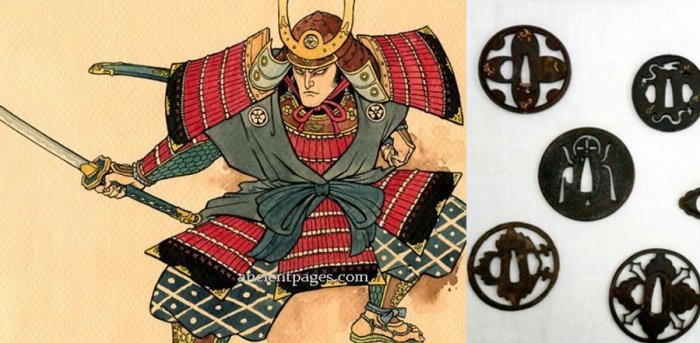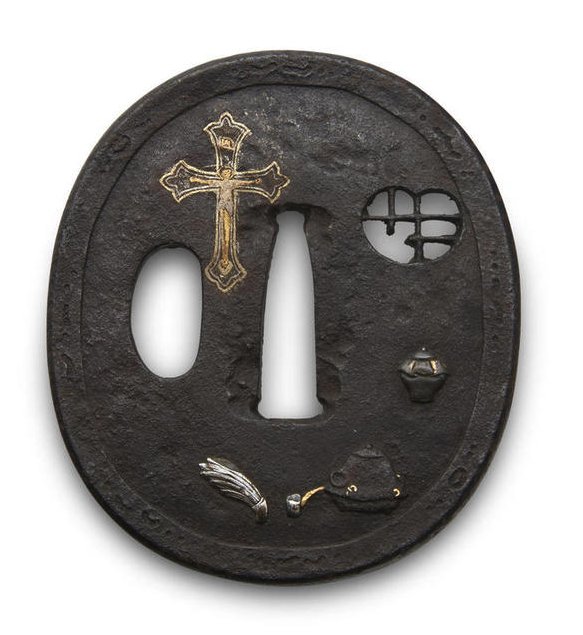Many Samurai Had Swords With Secret Crucifixes And Hidden Christian Symbols To Avoid Persecution
A. Sutherland - AncientPages.com - During the feudal era in Japan, also known as the Age of the Warrior, Christians were persecuted.
Christianity was banned in Japan, but some kept their deep faith despite persecution.
Left - Image source; Right: Image source - Sawada Miki Kinenkan Museum.
Hundreds of Japanese Samurai warriors were Christians, and they hid religious codes in their sword hilts. Several Samurai swords with secret crucifixes and hidden Christian symbols have been found.
The feudal era lasted from 1185 CE to 1868 CE. It was a time when the Emperor and the Shogun were the highest-ranking nobles.
The collapse of aristocratic rule ushered in a new age of chaos — appropriately called the Warring States period (c.1400-1600) — in which the military might dictate who governed and who followed.
During this period, Bushido, which means "way of the warrior," the warriors developed a code of chivalry as the samurai.
Early seventeenth century sword tsuba featuring an unusual crucifix in it’s decoration. Image credit: Revivaler
In 1549, Roman Catholic Jesuit missionaries led by Francis Xavier introduced Christianity to the East. Catholic missionaries initially brought the religion to the East around the mid-1500s.
However, it took only a short time before Christianity was banned. Toyotomi Hideyoshi (1536-1596), a Japanese warrior commander who later became an undisputed military dictator, prohibited the practice of Christianity and expelled all foreigners in 1638.
At the time, there were about 300,000 people in Japan. Many renounced their faith, and others went underground. Several Christians were also tortured and killed.
Samurais were banned from following religions after feudal Japan and many carried secret Christian symbols. Image credit: Sawada Miki Kinenkan museum.
Catholics who hid underground continued to practice their religion. They disguised images of Jesus and Mary to look like Buddhas and changed their prayers to sound like Buddhist chants.
At the Sawada Miki Kinenkan museum, several Japanese feudal-era sword guards are on display. These ancient swords offer evidence that Japanese Samurai warriors were Christians.
Forty-eight swords were identified to have belonged to Christians, and more than 10 of these could have been created somewhere between 1467 and 1568 during the Sengoku period. Having been among the Samurai's most important ornaments for their swords, the sword guards are believed to have been designed with hidden crosses to prove their Christianity, albeit in secret.
"A characteristic of sword guards made after anti-Christian measures were taken is that Christians carefully hid crosses in their designs.
We concluded the designs show the faith of hidden Christians, Yuhiko Nakanishi, chairman of the nonprofit group Nihon Token Hozon Kai, a Japanese sword preservation association, said.
Today, Christianity in Japan is a religious minority of about one million to three million people.
Written by – A. Sutherland AncientPages.com Staff Writer
Updated on February 8, 2024
Copyright © AncientPages.com All rights reserved. This material may not be published, broadcast, rewritten or redistributed in whole or part without the express written permission of AncientPages.com
Expand for referencesMore From Ancient Pages
-
 Strange Underwater Mini-Pyramid Older Than Stonehenge With Unknown Purpose – Who Built It?
Ancient Mysteries | Sep 12, 2021
Strange Underwater Mini-Pyramid Older Than Stonehenge With Unknown Purpose – Who Built It?
Ancient Mysteries | Sep 12, 2021 -
 Evidence Of Frightening Rituals Practiced By Ancient Steppe Nomads In Siberia – Discovered
Archaeology | Sep 19, 2020
Evidence Of Frightening Rituals Practiced By Ancient Steppe Nomads In Siberia – Discovered
Archaeology | Sep 19, 2020 -
 For The Ancient Maya, Cracked Mirrors Were A Path To The World Beyond
Featured Stories | May 25, 2024
For The Ancient Maya, Cracked Mirrors Were A Path To The World Beyond
Featured Stories | May 25, 2024 -
 Remarkably Well-Preserved 2,500-Year-Old Canoe Discovered In Swiss Lake
Archaeology | Sep 16, 2023
Remarkably Well-Preserved 2,500-Year-Old Canoe Discovered In Swiss Lake
Archaeology | Sep 16, 2023 -
 Sea Sequin ‘Bling’ Links Indonesian Islands’ Ancient Communities
Archaeology | Aug 16, 2023
Sea Sequin ‘Bling’ Links Indonesian Islands’ Ancient Communities
Archaeology | Aug 16, 2023 -
 The ‘Chinese Pyramids’ And The Pole Star
Archaeology | Nov 30, 2018
The ‘Chinese Pyramids’ And The Pole Star
Archaeology | Nov 30, 2018 -
 What Was The Law Of The Innocents?
Ancient History Facts | Feb 10, 2016
What Was The Law Of The Innocents?
Ancient History Facts | Feb 10, 2016 -
 Drought Was Not The Reason Cahokia, North America’s First City Was Suddenly Abandoned – New Study
Archaeology | Jul 4, 2024
Drought Was Not The Reason Cahokia, North America’s First City Was Suddenly Abandoned – New Study
Archaeology | Jul 4, 2024 -
 66 Diorite Statues Of Lion-Headed Goddess Sekhmet Discovered In Luxor, Egypt
Archaeology | Mar 9, 2017
66 Diorite Statues Of Lion-Headed Goddess Sekhmet Discovered In Luxor, Egypt
Archaeology | Mar 9, 2017 -
 Zerzura – Lost Ancient Sahara Oasis Guarded By Black Giants
Featured Stories | Jun 10, 2020
Zerzura – Lost Ancient Sahara Oasis Guarded By Black Giants
Featured Stories | Jun 10, 2020 -
 A 900-Year-Old Crusader Sword Discovered Off The HaCarmel Coast, Israel
Archaeology | Oct 20, 2021
A 900-Year-Old Crusader Sword Discovered Off The HaCarmel Coast, Israel
Archaeology | Oct 20, 2021 -
 Geri And Freki: Two Wolves ‘Greedy’ And ‘Ravenous’ Were Loyal Companions Of Odin In Norse Beliefs
Featured Stories | Feb 8, 2019
Geri And Freki: Two Wolves ‘Greedy’ And ‘Ravenous’ Were Loyal Companions Of Odin In Norse Beliefs
Featured Stories | Feb 8, 2019 -
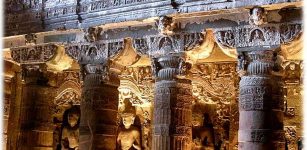 Ajanta Caves: Incredible Accomplishment Of India’s Ancient Stonecutters
Featured Stories | Oct 1, 2015
Ajanta Caves: Incredible Accomplishment Of India’s Ancient Stonecutters
Featured Stories | Oct 1, 2015 -
 Curly Hair Protected The Brain Of Early Humans And Helped It Grow
Human Beginnings | Aug 31, 2023
Curly Hair Protected The Brain Of Early Humans And Helped It Grow
Human Beginnings | Aug 31, 2023 -
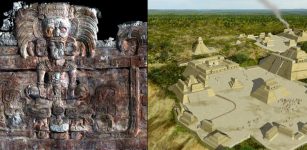 Spectacular Discovery Of Ancient Tombs Beneath Maya Pyramids Can Unravel The Mystery Of The Snake Kings
Archaeology | Oct 17, 2016
Spectacular Discovery Of Ancient Tombs Beneath Maya Pyramids Can Unravel The Mystery Of The Snake Kings
Archaeology | Oct 17, 2016 -
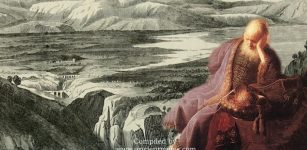 Tahpanhes – Biblical City Where Prophet Jeremiah And King Zedekiah’s Daughters Hid From The Babylonians
Biblical Mysteries | Jul 19, 2021
Tahpanhes – Biblical City Where Prophet Jeremiah And King Zedekiah’s Daughters Hid From The Babylonians
Biblical Mysteries | Jul 19, 2021 -
 Previously Uncounted Copies Of Newton’s Groundbreaking ‘Principia’ – Discovered
News | Nov 11, 2020
Previously Uncounted Copies Of Newton’s Groundbreaking ‘Principia’ – Discovered
News | Nov 11, 2020 -
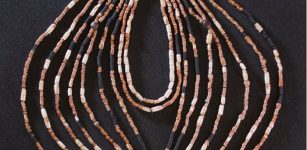 Beautiful Neolithic Ornate Necklace With Over 2,500 Stones Found In A Child’s Grave
Archaeology | Aug 2, 2023
Beautiful Neolithic Ornate Necklace With Over 2,500 Stones Found In A Child’s Grave
Archaeology | Aug 2, 2023 -
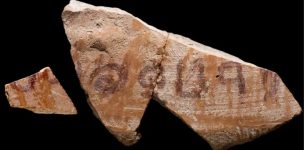 Rare 3,000-Year-Old Jerubbaal Inscription Of Biblical Judge Discovered In Israel
Archaeology | Jul 14, 2021
Rare 3,000-Year-Old Jerubbaal Inscription Of Biblical Judge Discovered In Israel
Archaeology | Jul 14, 2021 -
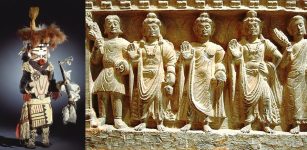 Mysterious Zuni Indians And Japanese People May Be Related – Did Buddhist Monks Reach North America In 1350?
Civilizations | Dec 26, 2017
Mysterious Zuni Indians And Japanese People May Be Related – Did Buddhist Monks Reach North America In 1350?
Civilizations | Dec 26, 2017

